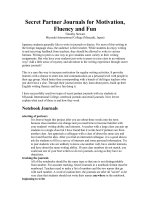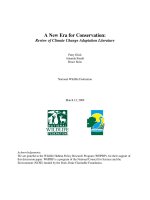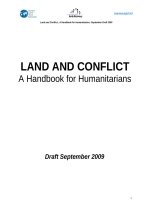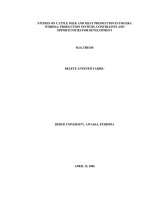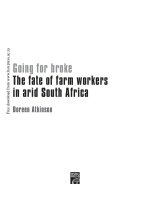Going for Broke doc
Bạn đang xem bản rút gọn của tài liệu. Xem và tải ngay bản đầy đủ của tài liệu tại đây (1.24 MB, 312 trang )
Going for broke
The fate of farm workers
in arid South Africa
Doreen Atkinson
Free download from www.hsrc
p
ress.ac.za
Published by HSRC Press
Private Bag X9182, Cape Town, 8000, South Africa
www.hsrcpress.ac.za
© 2007 Human Sciences Research Council
First published 2007
The views expressed in this publication are those of the authors. They do not
necessarily reflect the views or policies of the Human Sciences Research Council
(‘the Council’) or indicate that the Council endorses the views of the authors. In
quoting from this publication, readers are advised to attribute the source of the
information to the individual author concerned and not to the Council.
ISBN 10: 0-7969-2176-8
ISBN 13: 978-0-7969-2176-5
Copyedited by Angela du Preez
Typeset by Jenny Wheeldon
Cover design by Flame Design
Cover photo by Doreen Atkinson
Print management by comPress
Distributed in Africa by Blue Weaver
Tel: +27 (0) 21 701 4477; Fax: +27 (0) 21 701 7302
www.oneworldbooks.com
Distributed in Europe and the United Kingdom by Eurospan Distribution Services (EDS)
Tel: +44 (0) 20 7240 0856; Fax: +44 (0) 20 7379 0609
www.eurospangroup.com/bookstore
Distributed in North America by Independent Publishers Group (IPG)
Call toll-free: (800) 888 4741; Fax: +1 (312) 337 5985
www.ipgbook.com
Free download from www.hsrc
p
ress.ac.za
Contents
List of tables vi
Acknowledgements viii
Acronyms x
Map of South Africa’s arid areas xii
Chapter 1 The unseen plight of farm workers in South Africa 1
The aims of the book 1
Farmers, government, farm workers and the
unresolved policy void 3
The argument 8
A note on concepts and statistics 11
The genesis of this study 13
Chapter 2 The rise of an unfree labour system before 1970 15
Multiple perspectives of a complex history 15
Race, land and labour in South Africa in the
eighteenth and nineteenth centuries 23
The origins of the master-servant relationship after 1850 27
Entrenching farm labour servility after 1913:
farms as total institutions? 34
The leaven in the dough: paternalism and social bonds
on commercial farms 42
Why are there no white farm workers? 48
Conclusion 52
Chapter 3 The forces of modernisation after 1970 53
The changing basis of white commercial agriculture 53
The decline of the unfree labour system after 1970 58
Urbanisation dynamics after 1994 65
Free download from www.hsrc
p
ress.ac.za
Chapter 4 Government policy dilemmas after 1994 69
The evolution of rural development strategies 69
Ambiguity, indecision and confused loyalties 72
The Extension of Security of Tenure Act 79
Chapter 5 Life on the farm 91
Paternalism as social capital 91
The decline of paternalism? 96
The right to a grave? 99
The development gap 100
The vexed question of access to farms 108
Conclusion 109
Chapter 6 Leaving the farm 111
To move or not to move 111
Wage levels and the propensity to migrate 118
Employment, retrenchments and migration 126
Education and the propensity to migrate 130
Unresolved policy questions 131
Chapter 7 Civil society and farm life 133
The golden age of service delivery:
the Rural Foundation, 1982–1998 133
Filling the gap: civil society organisations
and service delivery 142
Possible new alternatives in the NGO sector 147
Conclusion 149
Chapter 8 Municipal political representation of farm dwellers 150
The honeymoon period: 1995–2000 150
Amalgamated municipalities and urban bias 158
Chapter 9 Service delivery and the micro-welfare system 164
Farming communities as micro-welfare systems 165
Farm workers on provincial government agendas 168
The contradictory approaches of government departments 174
Free download from www.hsrc
p
ress.ac.za
The triangular service delivery relationship 179
Municipal service delivery after 2000:
a patchwork of district and local functions 182
The role of municipalities in the rural areas 189
The beginnings of a municipal response 191
Conclusion 202
Chapter 10 Tough choices for service delivery 203
What rural services? 203
Linking finance to functions 210
The ‘where’ of development 215
Mobility and transport 223
Beyond infrastructure: towards enabling local government? 225
Chapter 11 The professionalisation of farm work 228
The legacy of poor schooling 229
Towards the professionalisation of farm work? 235
Informal training and professional advancement 242
Training providers 246
Conclusion 249
Chapter 12 A journey to somewhere? 250
Grazing and cropping rights 251
The ideal of farm ownership 254
The private sector’s role in land reform 256
The fate of unemployed farm workers 260
Commonage, peri-urban livelihoods and land reform 264
Institutional support 270
Policy questions 274
Conclusion: an outlook for the future 279
Notes 282
References 286
Index 297
Free download from www.hsrc
p
ress.ac.za
vi
List of tables
Table 2.1 Agricultural production by black farmers on white farms,
1922–1936 40
Table 3.1 Labour cost as percentage of total cost 57
Table 3.2 Various estimates of the number of farm employees 61
Table 3.3 Racial profile in agricultural employment, 1970–1995 62
Table 3.4 The urban population per settlement category
in the Free State, 1991, 1996 and 2001 64
Table 3.5 Number of farm workers on selected farms in
the Free State and Northern Cape, 2001 and 2003 67
Table 4.1 Land reforms undermined by evictions 85
Table 5.1 Farm workers’ views on helpful agencies 94
Table 6.1 Length of residence on farms and in the district,
Free State and Northern Cape, 2003 112
Table 6.2 Reasons for choosing farm work,
Natal and Eastern Cape, 1987 113
Table 6.3 Potential reasons for leaving farm employment,
Natal and Eastern Cape, 1987 116
Table 6.4 Farm workers’ income levels, Johannesburg sample, 1990 120
Table 7.1 Farms affiliated with the Rural Foundation and the
number of people reached, 1984, 1988 and 1992 140
Table 8.1 Equitable share received by TRCs in the Bo-Karoo
District Council, 1999–2000 157
Table 8.2 Funders involved in rural sanitation programmes,
Northern Cape, 2000/01 157
Free download from www.hsrc
p
ress.ac.za
vii
Table 9.1 Farm worker issues in Provincial Growth and
Development Strategies 169
Table 9.2 Agricultural and rural development issues in Provincial
Growth and Development Strategies 172
Table 9.3 District municipalities as Water Services Authorities
in rural areas 185
Table 9.4 Rural service delivery 186
Table 9.5 Service delivery to farm workers in municipal IDPs 194
Table 9.6 Municipal IDPs: service delivery to agricultural areas 196
Table 9.7 Spatial and demographic dynamics in municipal IDPs 197
Table 9.8 Peri-urban emergent and small-scale farming 200
Table 9.9 Land reform 201
Table 10.1 The applicability and practicalities of service delivery to
commercial farms 208
Table 10.2 Preferences for farm workers’ residence, nine Free State and
Northern Cape districts, 2003 217
Table 10.3 Frequency of visits to town 223
Table 10.4 Transport modes 224
Table 11.1 Changing employment patterns within agriculture,
1970–1995 236
Table 11.2 Formal employment and education in agriculture,
1970–1995 236
Table 11.3 Farmers’ views of farm workers’ training needs 243
Table 11.4 Training experience and training needs 245
Table 11.5 Farmers’ views of desirable training providers 246
Table 11.6 Farm workers’ preferences for training providers 248
Table 12.1 Farm workers’ ambitions to farm independently 254
Table 12.2 Farmers’ views of appropriate support providers for
emergent farmers 256
Free download from www.hsrc
p
ress.ac.za
viii
Acknowledgements
In many ways, the production of this book was a team effort. Several studies
were conducted, which were incorporated in the book. The author would like
to thank Prof. Retha du Plessis (Department of Social Work, University of
the Free State), as well as the hardworking staff of the Bloemfontein office of
the Human Sciences Research Council – in particular, Anja Benseler, Daniel
Pienaar and Ntobeko Buso. This book is a testament to the innovative work
conducted by the Bloemfontein office, which has unfortunately since closed.
Other important contributors were Rev. Carin van Schalkwyk, Mark Ingle,
Dr Marlene Roefs, Gwendolyn Wellman, Nhlanhla Ndebele, Victor Mbengwa,
Monyake Mothekhe and Pulani Simes.
Valuable financial support was obtained from the HSRC’s baseline funds and
the Free State Premier’s Economic Advisory Council. The book would never
have been produced without the moral support of Prof. Roger Southall and
Prof. John Daniel of the HSRC, as well as Prof. Lucius Botes and Mr Malinda
wa Mafela of the Centre for Development Support (CDS) at the University
of the Free State. Other staff members at the CDS also made valuable
contributions, and in particular, the author thanks Dr Lochner Marais and
Ms Anita Venter.
In addition, the financial support of the United States Agency for International
Development must be acknowledged. During 2002, they funded a study trip
to the US, to examine policies and programmes for farm workers. I would also
like to thank my co-travellers – Mr Mann Oelrich (then MEC for Agriculture
in the Free State), Mr Ike Tshitlho (Department of Local Government, Free
State) and Ms Baby Ramahotswa (Integrated Rural Development Planning
office, Pretoria) – with whom I had lively and informative conversations
during that visit. I would like to thank the numerous American officials in
California, Texas and Washington D.C. who made time to share their insights
and experiences with us. The project also draws on some work done by Daniel
Pienaar for the Food and Agricultural Organisation (Harare office), and we
would like to thank Ms Kaori Izumi for her support for the Bloemfontein
HSRC office.
Free download from www.hsrc
p
ress.ac.za
ix
In addition, we benefited from the research funded by the UK’s Department
for International Development (DFID) as part of their LOGOSUL programme
in the Northern Cape. During 2004, the Department of Water Affairs funded
research on service delivery to farm workers, for which we remain grateful.
I would also like to express my appreciation for the many farmers, farm
workers and municipal officials who shared their insights with us. The staff of
the erstwhile Rural Foundation were particularly helpful.
Finally, I would like to thank my husband and colleague, Mark Ingle, for his
unstinting moral support and his editing contributions.
Free download from www.hsrc
p
ress.ac.za
x
Acronyms
ABET Adult Basic Education and Training
AgriBEE black economic empowerment strategy for agriculture
AgriSA South African Agricultural Union
AgriSETA Agricultural Sector Education and Training Authority
CDA Community Development Association
DA Democratic Alliance
DC district council
DLA Department of Land Affairs
DM district municipality
DMA district management area
DoA Department of Agriculture
DoL Department of Labour
DPLG Department of Provincial and Local Government
DTI Department of Trade and Industry
DWAF Department of Water Affairs and Forestry
ESTA Extension of Security of Tenure Act
FDT Farmers’ Development Trust
GEAR Growth, Employment and Redistribution
HSRC Human Sciences Research Council
IDP Integrated Development Plan
ISRDP Integrated Sustainable Rural Development Programme
LM local municipality
LRAD Land Redistribution for Agricultural Development
Free download from www.hsrc
p
ress.ac.za
xi
MP member of parliament
NAFU National African Farmers’ Union
NDA National Department of Agriculture
NGK Nederduitse Gereformeerde Kerk
NGO non-governmental organisation
NP National Party
NPO non-profit organisation
NWGA National Wool Growers’ Association
PGDS Provincial Growth and Development Strategy
PRA participatory rural appraisal
RSC Regional Services Council
SAAU South African Agricultural Union
SETA Sector Education and Training Authority
StatsSA Statistics South Africa
TLC Transitional Local Council
TRC Transitional Representative Council
USAID United States Agency for International Development
WSA Water Services Authority
Free download from www.hsrc
p
ress.ac.za
G O I N G F O R B RO K E: T H E FAT E O F F A R M W O R K E R S I N A R I D S O U T H A F RI C A
xii
Map of South Africa’s arid areas
Research site
Free download from www.hsrc
p
ress.ac.za
CHAPTER 1
The unseen plight of farm workers
in South Africa
The aims of the book
Picture a government official or a municipal planner who is confronted with
the following five facts:
During the period from 1988 to 1998, the commercial farm sector
shed a staggering 140 000 regular jobs, a decline of roughly 20%.
(Simbi & Aliber 2000: 3)
For increasing numbers of migrants, migration will be in vain.
Those who are most likely to lose their jobs are unskilled or semi-
skilled workers with education levels that make it increasingly
unlikely that they will enter the formal economy. (Kok et al. 2003: 60)
Paradoxically, South Africa’s cities are the centre of the nation’s
wealth but also of its most abject poverty. Without access to land
or shelter, work or education, the urban underclass must find
resources to pay for basic services and costly rentals while they
fight to survive in hostile social and environmental conditions.
(Parnell 2004: 2)
The availability of basic services like water and sanitation varies
extensively amongst different farms. (CRLS 2001: 19)
The low levels of education and literacy in rural areas provide a
formidable barrier for rural people in engaging with the state and
with policy processes. (Husy & Samsodien 2001: 13)
These five statements capture a difficult dilemma. Conditions are poor on
many farms, so many farm workers are losing their jobs and moving to towns
and cities. But deep poverty already characterises the towns and cities, and
those farm workers who remain on the farms are unlikely to be able to make
their needs known. How can we plan services in ways that improve the living
1
Free download from www.hsrc
p
ress.ac.za
G O I N G F O R B RO K E: T H E FAT E O F F A R M W O R K E R S I N A R I D S O U T H A F RI C A
2
conditions of farm workers who remain on the farms, as well as of those who
have migrated to the towns, and whose presence will simply swell the numbers
of the urban poor?
This book focuses primarily on the practical issue of how government
officials and municipal planners deliver services. It questions the kinds of
government services that should be provided to farm workers. This question
naturally resolves itself into several subsidiary questions. These questions ask
the following: Who should provide these services? At what cost, and with
what funding? Furthermore, where should such services be provided? On the
farms, or in the towns? Or in specially created farm workers’ villages? But in
addressing these practical developmental questions, it becomes apparent that
the farm labour issue is a prism through which we should explore a much
wider range of far-reaching social phenomena. For example, the practical
issues of service delivery give rise to profound questions about the future
of agricultural labour. What are the employment trends with regard to farm
labour? What kinds of farm work will predominate in the future? Will farm
workers be permanent or casual, and will they reside on or off the farms? What
remuneration and benefits will they derive from agricultural employment?
Will the living conditions of farm workers improve or deteriorate? What
commuting and transport arrangements would be most effective?
These questions, in turn, presuppose an understanding of the current rural
order and of its changing spatial complexion. Why do so many farm workers
leave the farms – do they choose to do so, or are they forced out? Will migrant
and temporary farm workers, whom contractors often manage, replace
permanent and on-site farm workers? And is it really in the interests of
contemporary farm owners to maintain a class of servile and subservient
unskilled farm workers? These questions raise another, pivotal, question about
the future livelihoods of farm workers. Will there be a return to sharecropping,
or an advance to new forms of profit-sharing with commercial farmers?
Will we see the promotion of some workers into a stratum of highly skilled
professional farm managers? Do farmers and farm workers see possibilities for
economic co-operation on a more equal footing? Are there unexploited political
resources for farmers or for farm workers – through either party structures or
interest groups – which may affect development policies and programmes?
These spatial, social and economic questions have implications for land
tenure and rural development. Where, if at all, should farm workers enjoy
Free download from www.hsrc
p
ress.ac.za
T H E U N S E E N PL I GH T O F FA R M W O R K E R S IN S O U T H A F R I C A
3
secure land tenure – on the farms (as land legislation now provides for), in the
towns or in special agri-villages? Will farm workers acquire their own farms
through the land redistribution programme? Will at least some farm workers
move from working on farms to owning farms? Could such a policy of farm
ownership work? And if it could, what kind of preconditions would have to
accompany the policy?
At the same time as these issues arise, there are indications that the normative
social relationships between employers and farm workers are changing. Are
farmers still comfortable with a highly unequal social relationship? Do elements
of social paternalism remain in the relationships between farmers and farm
workers? And if so, is this a good thing? Is there a trend towards a greater degree
of professionalisation of farm work and of new management methods? How
might this affect the social and status relations of farmers and farm workers?
And underlying these issues, of course, is the question about whether trends
are moving away from the rigid gridlines of racial stratification.
This book is a first attempt at putting these questions on the national policy
agenda. Currently, the government has no specific policy towards farm
workers. The author hopes that this book will, at least, identify the areas
for investigation so that the government can draft a comprehensive policy.
Commercial agriculture still provides about 10 per cent of formal employment
in the economy (Simbi & Aliber 2000: 8), which is a major consideration in
protecting on-farm jobs. The aim of this book is to stimulate questions
about the future of farm work and about the livelihoods of farm workers.
In particular, the author hopes that the book will promote further research
on commercial agriculture, farm labour, rural-urban migration, land
reform and emergent smallholder agriculture. Ideally, such research should
engage with the enormous complexities of and variations in farm workers’
experiences. It should also engage with possible policy options to promote
farm workers’ livelihoods.
Farmers, government, farm workers
and the unresolved policy void
Because farm workers are dispersed among farms in areas that are often
remote, farm workers as a class are invisible in society. A chronic powerlessness
Free download from www.hsrc
p
ress.ac.za
G O I N G F O R B RO K E: T H E FAT E O F F A R M W O R K E R S I N A R I D S O U T H A F RI C A
4
in their job situation frequently matches their lack of public profile. This
powerlessness arises from the unskilled or semi-skilled nature of much farm
work, which means that one farm worker can be replaced by another relatively
easily. Farm workers who live at their place of work are mobilised with
great difficulty, whether by trade unions or by government agencies. Their
relationships with their employers – which may be positive or negative – tend
to be more important than their relationships with their peers who work on
neighbouring farms. Farm workers are often the last social constituency that
government agencies reach. This is because farm workers are geographically
remote. The need to negotiate the relationship with that most important
of mediators, the employer, also plays a part in this distance. Where farm
workers lack basic forms of communication, such as telephones or vehicles,
the difficulties of mobilisation, or of simply creating opportunities for
camaraderie, are greatly exacerbated.
These problems characterise farm workers throughout the world, but they are
particularly intense in South Africa. The history of farm workers and their
current social and economic problems are a product of colonialism, segre-
gation, apartheid, capitalist development, and post-apartheid development
thinking. This book is about the plight of a social constituency which has
been moulded, manipulated, and, more recently, marginalised, by those with
economic and political power. Farm workers’ status and situation has changed
massively during the last hundred years, due to sudden and dramatic reversals
in political and economic interests and fortunes. Ironically, and tragically,
the post-apartheid government’s attempts to improve the situation of farm
workers have been based on a lack of understanding of the longer-term and
underlying forces that shape the pressures on farm workers and their families.
The result is that most farm workers’ circumstances have worsened.
This book is about these invisible workers, and the families that depend on
them. It is about their social and economic history, which forms the backdrop
to their current experiences. It is about their current place in the social
and political order. It examines public attempts to improve the lot of farm
workers, and it also addresses farm workers’ future prospects within a rapidly
changing economy.
This book is by no means a complete and exhaustive study of farm workers’
lives and livelihoods in South Africa. In general, the book focuses less on
labour relations and tenure issues, and more on service delivery and public
Free download from www.hsrc
p
ress.ac.za
T H E U N S E E N PL I GH T O F FA R M W O R K E R S IN S O U T H A F R I C A
5
policy. This means that key topics related to ‘employment justice’, such as
the emergence of labour contractors, unionisation and foreign immigrants,
are not covered in detail. The study is also biased along geographical lines.
This is because it foregrounds the experiences of farm workers in the
extensive agricultural areas of the arid and semi-arid pastoral regions of
the southern Free State and Karoo. It focuses less on the provinces where
intensive agriculture is practised. As such, some of the findings cannot be
regarded as definitive. A great deal more empirical work is required, on issues
that are not addressed adequately, as well as on the wide range of empirical
variations and exceptions that characterise farm labour in South Africa. Our
research is currently based on small and localised samples. It is instructive to
compare our research efforts with the United States, where an annual National
Agricultural Workers Survey includes a sample of 4 000 farm workers each year
(Gabbard 2002: 16). There is enormous scope here for an entire generation
of postgraduate students and researchers in economics, sociology, political
science, public policy and development planning.
Furthermore, there is even greater scope for comparative international studies
on the socio-economic status of farm workers and on the policy initiatives that
can be used to improve their situation. This book includes some comparative
findings from the United States. While readers may feel that the comparison
with a strong developed economy may not be particularly apt, this is not the
case. Many farm workers in the US are Hispanic migrant workers, who are
marginalised because of their culture, language and low level of education,
and by their lack of permanent residence and tenure rights. There is a great
deal to learn from policy initiatives in the US and in other countries. This
book provides some examples of these policy initiatives.
Defining the core issues is a complex task. Even the ‘problem’ is not clearly
understood. Is it a problem of absolute levels of poverty among farm workers?
And if so, why exactly is poverty so widespread? Or is it a problem of the
cultural marginalisation of farm workers, their geographic dispersal and
their being sidelined from the mainstream of urban life? Should we rather
be concerned about the relative poverty of farm workers in relation to other
sectors of society? Perhaps the problem is that farm work is simply not much in
demand any more, and that farm workers, who may have valuable agricultural
skills, find themselves rootless in an increasingly modern and urbanised
society. Perhaps the problem lies with the fact that the entire agricultural
Free download from www.hsrc
p
ress.ac.za
G O I N G F O R B RO K E: T H E FAT E O F F A R M W O R K E R S I N A R I D S O U T H A F RI C A
6
sector is suffering the painful adjustment to a globalised market, so that
farm workers’ interests suffer. Perhaps it is a problem of social inequality, the
sheer fact of farm workers’ social powerlessness and vulnerability relative to
their employers. Or is it a problem of land tenure insecurity? Or that farm
workers have great difficulty in securing land of their own, so that they remain
within the agricultural sector but cannot graduate to becoming independent
producers? Is it a problem of too much modernity, not enough modernity, or
modernity of the wrong kind? Numerous people, including policy-makers,
have a vague and discomfiting feeling that all is not well with farm workers,
but few people have unpacked their concerns to explore the underlying
theoretical assumptions of these concerns. This is a measure of the vacuum in
thinking about rural development in commercial farming areas.
Defining the problem would entail many arguments and many books. Each
of the problems listed above will have passionate advocates for it being the
primary problem. And among these advocates, there will be fervent believers
that one single solution is the best one. There is, therefore, sufficient food
for thought here to keep dozens of philosophers, researchers and analysts
intellectualising for a long while.
In the meantime, the distress signals are becoming clearer. These include:
• The rapid rate of job losses in agriculture;
• Accelerating rural-urban migration and burgeoning informal settlements
around the towns and cities;
• The very slow pace of land redistribution, particularly to ex-farm workers;
• The enormous pressure on communal agricultural land, particularly
municipal commonage;
• The decline in government services to farm workers;
• The confusion and lack of synchronisation among government
departments about policies and programmes aimed at the rural poor
(including farm workers);
• The scarcity of formal agricultural training;
• The fundamental lack of capacity of most district and local
municipalities to deliver any services at all to farm workers.
Political tempers have frayed because these distress signals are not being
addressed. Many farmers have taken the law into their own hands, and have
evicted their farm workers with varying degrees of heartlessness. Public-
spirited NGOs despair at the magnitude of the task to bring about a just
Free download from www.hsrc
p
ress.ac.za
T H E U N S E E N PL I GH T O F FA R M W O R K E R S IN S O U T H A F R I C A
7
rural social order. Farmers’ unions oscillate between despair and anger at
the inability of the state to address rural problems. The Department of
Land Affairs and human rights advocates resort to enforcing land tenure
legislation with increasing determination, often demonising an entire stratum
of employers in the process. Many anxious farmers feel that land tenure
legislation is the thin end of the wedge of a Zimbabwean-type land solution of
nationalisation and indiscriminate land-grabbing. Some municipalities have
resorted to levying high rates on farms in an attempt to boost ailing municipal
revenues. Disaffected farmers and landowners have repeatedly resorted to the
courts to secure some kind of procedural and substantive justice in the face of
a government that appears to move between confusion and hostility.
The problem needs some clear thinking urgently – not only for damage control,
but to salvage what is actually good about the current rural social order, and to
determine what kinds of governmental policies and commercial interventions
are needed to create a viable and just rural economy and society.
This book is aimed primarily at policy-makers, to assist them in understanding
the position of farm workers within the broader socio-economic context of
rural South Africa. In contrast to other public policy arenas, the current and
future status of commercial agriculture, and especially the position of farm
labour, is relatively under-researched. Consequently, valuable developmental
opportunities are being lost. Many farm workers have shown an extraordinary
degree of adaptability and initiative in maintaining a precarious foothold
in the economy. Farm workers often have valuable agricultural skills and
experience, which could be utilised to much greater effect. In many settings,
part-time and small-scale agriculture offers unemployed farm workers an
opportunity to make a living. These may well be promoted to boost the
economies of small towns. The status of farm workers is, on the one hand,
a case of tragic neglect. On the other hand, it offers enormous potential for
a much-needed economic boost in the rural areas of South Africa. Public
policy-makers in South Africa have not recognised this potential, with the
partial exception of ambitious land reform schemes. In addition, commercial
agriculture offers valuable opportunities for improving the training and
managerial skills of those farm workers who do keep their jobs, in an age of
globalisation and stringent economic competition. The positive attitudes of
many farmers towards ensuring farm workers’ progress also provide a source
of important and under-utilised social capital.
Free download from www.hsrc
p
ress.ac.za
G O I N G F O R B RO K E: T H E FAT E O F F A R M W O R K E R S I N A R I D S O U T H A F RI C A
8
The argument
This book makes several arguments. The arguments straddle the disciplines of
sociology, economics, politics and policy science. It is unabashedly normative,
since its overriding goal is to ameliorate the plight of farm workers by means
of public policies. Its goal is also to suggest some meaningful opportunities
for the private sector to become involved. Emphatically, the work does not
pretend to offer an exhaustive compendium of all the issues and ramifications
related to farm labour. It highlights a selection of issues that need to be
explored further.
The book argues seven points. Firstly, during the twentieth century, the
class of black and coloured farm workers was created deliberately as a
marginalised and super-exploitable labour force. This trend preceded the
advent of National Party apartheid policy in 1948, and can be traced back to
the nineteenth century.
Secondly, although farm workers have been extraordinarily powerless,
significant social relations have often developed between them and their white
employers. This has created a paternalistic social order on the farms – albeit
on highly unequal terms – which offers an underestimated and neglected
opportunity for interracial social cohesion and co-operation. The bedrock of
paternalistic social interaction is, however, being rapidly eroded. This is partly
due to economic forces, and partly due to government policies that attempt
to replace the interaction with a direct relationship between farm workers
and the state. Generally this move has failed to deliver real material support
to farm workers. Rather, it has left them in a super-marginalised position
with respect to their employers as well as to the state. This lamentable state of
affairs needs to be analysed in much more detail, and a coherent social policy,
based on clear normative choices, needs to be developed to address it.
Thirdly, the provision of public services to farm workers has deteriorated
significantly since 2000. The end of apartheid in the late 1980s and early 1990s
was associated with a rapid expansion of innovative service delivery to farm
workers. This should have laid the groundwork for a much stronger rural
society. Between 1994 and 1999, some of these innovations began to crumble
due to government disinterest, but new initiatives by district municipalities
temporarily outweighed this decline. After 2000, the picture became very bleak.
Free download from www.hsrc
p
ress.ac.za
T H E U N S E E N PL I GH T O F FA R M W O R K E R S IN S O U T H A F R I C A
9
With rural areas having been incorporated into municipalities and subjected
to a strong institutional urban bias at local government level, a service delivery
vacuum has developed. This requires several lines of inquiry. The actions and
political ethos of municipalities, and the perverse, built-in incentives implicit
in the new municipal system, need to be examined. The ideological blind
spots of the government also need to be identified, understood and unpacked
into manageable policy components, so that a new governmental vision for
rural development can be constructed. In addition, the precarious social and
economic position of recent farm-worker immigrants into the towns and
cities needs to be understood. This is because these immigrants have become
the lumpenproletariat of a hugely unequal urban class society.
Fourthly, the ‘development gap’ as experienced by farm workers has to be
understood very much better, before social policy is designed. A century of
marginalisation has created a farm-worker sector that is hopelessly unequal
to the task of dealing with the challenges of modernity. This book will argue,
however, that these farm workers might yet harness their agricultural skills
to develop future livelihoods. The life-world of the farm worker, therefore,
has to be conceived in a much more nuanced and multidisciplinary way. This
understanding should encompass dysfunctional household dynamics, gender
inequality of often the most oppressive sort, poor education, a lack of social
and organisational skills or experience, an enormous want of confidence
and self-esteem, a lack of appropriate language skills to negotiate modern
institutions and, all too often, chronic substance abuse. At present, the few
governmental development opportunities that exist for farm workers, such
as land reform, do not adequately address these social realities. There is an
urgent need for participatory and bottom-up planning, which will require
long-term engagement with farm workers and their families.
Fifthly, there is a long-term and remorseless trend in the loss of agricultural jobs,
with a consequent drift to the cities. In South Africa, this has amounted to a
demographic and societal revolution in the countryside – one which has found
no echo in government policy. The implications of this drift are far-reaching,
especially regarding the provision of urban livelihoods and services. The drift
also affects the future development trends of small towns, medium-sized towns
and cities. Several key policy interventions need to be put into place. Appropriate
spatial planning and productive infrastructure needs to be provided, and the
commercial and institutional capacity of these urban areas needs to be boosted.
Free download from www.hsrc
p
ress.ac.za
G O I N G F O R B RO K E: T H E FAT E O F F A R M W O R K E R S I N A R I D S O U T H A F RI C A
10
Sixthly, the usefulness of farm work and experience needs to be recognised
and capitalised on. In the current South African economic context of jobless
growth, a person who has had a job at some period in his or her lifetime –
even a menial one – has an advantage over the many people who have
never had a job and have no prospect of ever securing one. Despite its
many drawbacks, farm labour provides a social and economic resource,
which needs to be nurtured. Many farm workers have some understanding
of crops and animal husbandry. They have some idea of how an income
can be generated, they know about the risks and disasters associated
with agriculture, and some have an appreciation for natural resource
management and infrastructure maintenance. These are valuable assets in an
economy characterised by the profound alienation of many people from the
factors of production.
Finally, the creative developmental opportunities that are available need to be
identified and explored. Many nascent social and economic resources exist
which have not begun to be exploited properly. Some initiatives that need to
be considered are:
• The use of municipal commonage;
• The creation of peri-urban spatial land-holdings, possibly as a stepping-
stone to larger-scale land reform;
• The improvement of local agricultural infrastructure and marketing;
• The promotion of agricultural support for part-time and smallholder
farmers by resourceful institutions such as commercial farmer unions
and co-operatives;
• The promotion of relevant and appropriate agricultural skills;
• The promotion of urban agriculture and small-scale agricultural processing.
There are many international precedents for successful development
programmes that incorporate these elements. A few have been tried in South
Africa, although there are some notable exceptions that have not.
Farm labour forms part of arguably the most neglected, marginalised and
disempowered social category in South Africa. But, paradoxically, it offers
such extraordinary and readily attainable economic and social opportunities.
This book does not intend to criticise or blame. It has been written to flag
a desperately urgent social tragedy in the making. It aims to draw attention
to the plight of a group that has virtually no champions of its own. It also
Free download from www.hsrc
p
ress.ac.za
T H E U N S E E N PL I GH T O F FA R M W O R K E R S IN S O U T H A F R I C A
11
advocates the launch of a number of development strategies that draw on
a wide range of public and private resources and energies. As such, it is an
optimistic book.
A note on concepts and statistics
Figuring out what agricultural statistics actually mean is an art. It is too
easy to misinterpret statistics, because they can mean many different things.
Consequently, readers can challenge some of the overarching trends identified
in this book on the grounds that they do not reflect reality in a specific
locality or with reference to a particular social category. This section offers a
few caveats. Firstly, it is almost impossible to overemphasise the enormous
differences between individual farms and between areas of the country, in a
multitude of aspects of farm life (Wilson 1977: 195). This affects, for example,
wages, housing, management practices, schooling and migration patterns.
These differences occur because farms were never subjected to general
industrial legislation, so each farmer developed a sui generis labour relations
system. General claims about farm labour trends should therefore be used
cautiously, as the exception is sometimes almost as important as the rule. The
reader should particularly beware the political, symbolic and rhetorical use of
generalisations. It is quite possible to portray farmers and farm workers in a
very positive or very negative light using selective statistics as a basis. So this
book repeatedly warns of the need for specific and localised research.
There are many types of localised differences between farms and farming areas.
In some parts of the country, or in some types of agricultural operations, the
impact of mechanisation may be to increase or reduce employment. The ratio
between regular and casual workers may change in unexpected ways. The ratio
between on-farm and migrant workers may show very different trends. Or the
impact of exchange rates or interest rates may have contradictory results. As
Roberts (1959: 4) notes: ‘Each farm is in a sense unique, so that an accurate
system of sampling is virtually impossible to formulate.’
A further source of confusion is that counting seasonal workers is a
particularly hazardous exercise. It is profoundly influenced by the time of year
in which a survey is conducted. Conducting a survey during harvest-time will
dramatically inflate employment figures.
Free download from www.hsrc
p
ress.ac.za
G O I N G F O R B RO K E: T H E FAT E O F F A R M W O R K E R S I N A R I D S O U T H A F RI C A
12
Finally, many key concepts have meanings that vary widely. For example,
‘casual work’ can be variously defined as work done by seasonal, occasional
or part-time workers. ‘Casual workers’ may form skilled teams who market
their work to farmers on their own terms (such as builders or shearers). Or
they could be workers who are recruited by commercial contractors. They
could also be unskilled labourers who are desperate for work on any terms.
Furthermore, migrants or on-farm residents may perform ‘casual work’. These
options have very different implications. Different types of people perform
them, in a wide array of situations and conditions. Take, for example, the
case of a migrant worker who is employed for eight months on a commercial
farm. He is not ‘regular’, because he is not in farm wage employment for the
whole year, and he therefore may miss out on a range of employment perks.
But he is not a casual worker who is employed for only two weeks. It is likely
that respondents in censuses or surveys interpret terms such as ‘regular’ and
‘casual’ in very different ways (Hendrie 1977: 187).
Similarly perplexing concepts and terms are ‘wages’, ‘migration’, ‘child labour’
and ‘labour shortage’. For example, it is well known that wages include
cash and in-kind wages. But the ways of calculating in-kind wages can vary
enormously. If proxy prices are used for, say, housing, food, clothing and
medicines, such proxies may be based on the real costs to the farmer. Or they
may be based on the notional prices that farm workers would have to pay
if they bought these services from other providers, or what urban workers
would have to pay to access comparable services in the cities (Hendrie 1977:
188). Depending on the proxy prices that farmers use, farm wages could seem
appallingly low or quite generous. No wonder, then, that there is so much
disagreement among organised labour and its critics about the conditions of
farm work!
The term ‘migration’ is equally multifaceted. As the book will show later,
migration could refer to permanent migration, short-term or circular
migration, or the movement of itinerant workers. Furthermore, the migrant
labour system variously refers to families living in the former homelands and
their wage earners working on the farms, or to families living on commercial
farms and working elsewhere, on other farms or in the towns. All of these
different types of migration take place simultaneously. So it is important
to figure out which types of migration seem to be predominant, at least in a
certain geographic area or in a specific type of farming operation. It is also
Free download from www.hsrc
p
ress.ac.za
T H E U N S E E N PL I GH T O F FA R M W O R K E R S IN S O U T H A F R I C A
13
important to discover how such predominant types of migration may be
changing over time. This is a hugely complex exercise, and the data are often
simply inadequate for showing what is actually happening.
Another source of confusion is the term ‘shortage of labour’. This could
refer to an absolute shortage of available workers, or to a lack of labour
supply at a prevailing wage, or to an unavailability of workers due to a lack
of suitable transport or housing, or to farmers’ reluctance to comply with
labour or tenure laws. The farm labour market does not operate according to
price signals only, but it has always been profoundly affected by government
legislation, service delivery and policies, which impact on numerous aspects
of the supply-demand relationship (Wilson 1977: 196). This applies as much
to the pre-1994 regime as to the post-apartheid government.
Finally, the definition of child labour is also open to debate. The term covers
a wide range of practices, from full-time labour during the week that causes
children to miss school, to odd jobs on weekends for pocket money. In some
cases, child labour is intrinsic to a farm’s production system, and the abolition
of child labour may require the farmer to reorient his or her entire business. In
other cases, child labour is a way for farm worker families to supplement their
income, or for the children to accumulate money for luxuries.
These conceptual and statistical problems raise important questions for
researchers collecting comparable and longitudinal data in the future. Much
more synergy is needed among researchers to collect similar types of data,
using the same instruments. Securing research co-operation by researchers
located throughout the country and in different types of institutions will go a
long way towards refining our databases.
The genesis of this study
This research began in a piecemeal fashion. In 2002, the Human Sciences
Research Council (HSRC) undertook a survey of 64 farmers and 64 farm
workers, in nine localities in the Free State and Northern Cape (Atkinson
2003).
1
At the same time, USAID funded a study tour of the United States to
enable an HSRC-led team of researchers to examine policies and programmes
for farm workers in the USA. Further qualitative studies were undertaken
in the Free State. These include a study of civil society organisations that
Free download from www.hsrc
p
ress.ac.za

